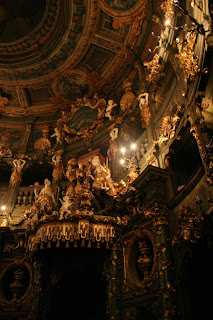
Sanctus sanctus sanctus dominus deus sabaoth Pleni sunt caeli et terra gloria tua. Holy, holy, holy lord God of hosts, Heaven and earth are full of your glory.
Two things that were new to me: Singing as part of a regular series of weekly Latin mass, and singing in a church building with a placard on the outside that reads, "This building has been seismically retrofitted to reduce the risk of death or injury in the event of a major earthquake..."
The tradition of having mass in Latin does not go back to the days of Jesus, but does go back to the days of Constantine, and spread along with Christianity. Discontinuing its general use was part of Luther's reformation in the 16th century. For Roman Catholics, its general use ended much later, as a result of the Second Vatican Council in the 1960s. However, St. Patrick Catholic Church, 756 Mission St. in San Francisco, is still working hard to keep this tradition alive. Another thing that was new to me and will require a lot more practice: they actually use Gregorian musical notation, both on some sheet music and in the book with the order of worship.
My job brought me to San Francisco for the American Geophysical Union conference, and after some attempts at contacting other churches at which to sing on December 20, I found that St. Patrick is very close to the conference site, the Moscone Center. However, I was able to attend the pre-mass rehearsal and only the first 15 minutes of the mass, after which I needed to leave to catch a flight back to Michigan.
 I was welcomed by a very small but mighty all-male group of singers--the photo shows the entire group plus the organist. Chris is the interim director, although it seemed that there was a large amount of direction by committee, especially trying to bring me up to speed with the music in a short amount of time.
I was welcomed by a very small but mighty all-male group of singers--the photo shows the entire group plus the organist. Chris is the interim director, although it seemed that there was a large amount of direction by committee, especially trying to bring me up to speed with the music in a short amount of time. I'll again define some terms that came up in a previous post. In liturgical talk, 'ordinary' used as a noun refers to the parts of the mass or worship service that are always used, or nearly so. This choir didn't bother rehearsing these, as they already know them. 'Proper,' used as a noun, means things that are used only for one Sunday, the fourth Sunday in Advent in this case. The main thing that we did that was a proper was a Gregorian chant based on Isaiah 45:8 and Psalm 18. We also did a setting of 'Ave Maria' and rehearsed a plainchant of 'Veni veni Emanuel' or 'O Come O Come Emanuel,' as well as some singing in English, whose title I didn't get around to writing down.
In retrospect, a particular feature of my experience at this church was that a lot of action occurred in a short amount of time, so that within the first 15 minutes of the mass, I heard a lot of music in Latin. 'Veni veni Emanuel' was skipped altogether without my even anticipating that it was coming; I think that Christmas is coming this week anyway.
Also quite unusual was the physical setup of the choir. St. Patrick is a rather large and elaborate Catholic church. The balcony in the back covers the entire width of the building, but is quite shallow and bare. The main thing there is the organ console with the organ pipes above. There are a couple of additional small benches there, but they weren't used. Instead, the small choir crowds around the organ console, in part because the main source of light in the balcony is lamps placed on the console. A short person would have difficulty looking over the top of the console to see their music.
The Latin Mass Choir of St. Patrick is a small group with much musical talent, who are very dedicated to a niche style of worship that connects people back to the church of about 1700 years ago. Although there was a respectable turnout of parishioners for this mass, this group is struggling to keep their tradition alive.
 Another humorous experience occurred on my way to this church on Sunday morning. I passed by the Macy's store on Union Square in San Francisco, and people were gathering outside the door. It became apparent that they were evacuating because of an emergency. Pretty soon Santa Claus made good his escape, too, and after another minute or so, I started hearing the sirens of a fire truck.
Another humorous experience occurred on my way to this church on Sunday morning. I passed by the Macy's store on Union Square in San Francisco, and people were gathering outside the door. It became apparent that they were evacuating because of an emergency. Pretty soon Santa Claus made good his escape, too, and after another minute or so, I started hearing the sirens of a fire truck.






















